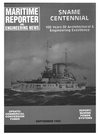
Page 105: of Maritime Reporter Magazine (September 1993)
Read this page in Pdf, Flash or Html5 edition of September 1993 Maritime Reporter Magazine
prime mover which can develop the necessary concentration of power | within a limited envelope.
Following the record-breaking crossing of the Atlantic by the heavily-sponsored express yacht
Destriero, with three GE-MTU LM 1600 gas turbines driving KaMeWa water jets, the large Aquastrada- type monohull light-alloy ferry
Guizzo will shortly take up regular commercial service between the Ital- ian mainland and Sardinia, cutting the crossing time from seven to three hours. Built by Cantieri Rodriqiez, best known for its hydrofoil craft, the Guizzo has a GE-MTU LM 2500 gas turbine, flanked by two of MTU's latest 16 V 595 diesel engines, all driving KaMeWa water jets.
The ferry industry was shaken by the order for two giant HSS (High
Speed Service) light-alloy catama- rans which the Swedish Stena Line has just placed in Finland. One is for service across the Irish Sea, which has notoriously bad weather, com- mencingintheSpringofl995. These craft, 406 feet long with a 131-foot beam, will be able to carry 1,500 passengers, 50 trucks and 100 cars, or 375 cars at a speed of around 40 knots, maintained in head sea wave heights of over 13 feet. They will introduce a fivefold increase in dead- weight capacity over the present largest craft of this type and, for the first time, be able to carry large commercial vehicles. The power required to achieve this performance is immense and will be provided by four GE gas turbines, one LM 2500 and one LM 1600, each driving a
KaMeWa steerable water jet through MAAG reduction gears in each hull; a total of 60 MW (81,600 bhp).
Japan's Techno-Super Liner is another active project, an SES freight-carrier to carry 1,000 tons at 50 knots over distances of500 miles, on lengthy inter-island of coastal voyages to avoid the overcrowded roads in the narrow littoral strip.
Two reduced-scale prototypes are being built; one a hybrid hydrofoil
TSL-F with a submerged buoyancy hull and the other a hybrid air cush- ion craft TSL-A, with lift-assist air fins. All seven major Japanese ship- builders are involved in the project, the most advanced prototype being the TSL-A, jointly by Mitsubishi and
Mitsui. The TSL marks the return of Turbo Power and Marine Sys- tems (Pratt & Whitney) to the ma- rine gas turbine field. They are cooperating with Mitsubishi in the
MFT-8 gas turbine, for which they are providing the gas generator core, based on that of their well-proven
JT8D-200 aircraft engine, with vari- able-geometry inlet guide vanes and variable compressor stator vanes.
For the prototype application, two
MFT-8 turbines, rated 20.6 MW (28,000 bhp) will be installed, but the machine will be capable at the introductory stage of 24.2 MW (33,000 shp), with output shaft speeds of 3,000, 3,600, and 5,000 rpm in both directions of rotation.
The fuel consumption is 0.217 kg/ kW/h (0.3631 lb/shp/h) at 24.9 MW mcr. The anticipated operating cost suggests that the value and urgency
September, 1993 of the goods carried would have to be high to attract the required freight rate. The military potential would be as a troop- or stores-carrier to serve locations without an air strip.
Couplings
Once-tolerated levels of noise and vibration in living and working spaces are no longer acceptable, not only in passenger-carrying ships, but in cargo vessels where health and safety at work legislation also ap- plies. Medium-speed engines, the principal offenders in this respect, are now generally installed on resil- ient mountings, with flexible sus- pension of the exhaust system and non-rigid connections in the pipe work supplying essential services.
This calls for some form of flexible coupling between the engine crank- shaft and the pinion shaft of the solidly-mounted gearbox to accom- modate large transient and small permanent malalignments: radial, angular and axial such as can arise from settling of the engine mounts, shock and movement of the founda- tions due to bad weather or loading.
These couplings take many forms, the Vulkan RATO system of seg- mental bonded rubber elements be- ing the most popular.
Geislinger's latest Gesilco cou- (Continued on page 101)
REDUCE STRESS & LIVE LONGER ^jfltKlfe1 Protect Valuable Equipment with |j. "Jtffc^ 1 Advanced Damping Technology ^flf I \ £\ of Holset Resilient Couplings •A flft ' • Absorb Vibration & Shock Loads •PPH^L ^ m Jjj^^^Bk • Tune Out Resonant Vibration
S* w \\ * Long Life, Heavy Duty Design pP fJjp^r^E M • No Lubrication. Ever! | Vihration ^fcfe ^ / t JB group offers a precise study of your
V ..g^flf complete drive system •Holset * „ . IBy combines 43 years experience with the
H 1 latest analytical techniques to insure ^HHr f/m 1 I your system is safe from damage by ufc I * Mtm torsional vibration • Services range from
MMh^. iJ^Z ^ I system design consulting and computer analysis to on-site measurement of ^^^^^^ vibration • Holset also offers custom engineered couplings, utilizing their proprietary rubber compounds, for your specific requirements • Holset specializes in practical solutions to torsional vibration problems in most industries, including: diesel & marine drives, electrical drives, metal working mills, mining, petrochemical, and utilities.
Call the vibration engineering experts today 1-800-852-6648
HOLSET
Holset Engineering Co. Inc.
Suite 500, Dept. SH 1320 Kemper Meadow Drive
Cincinnati, Ohio 45240
FAX: 513-825-2967
Circle 158 on Reader Service Card

 104
104

 106
106
